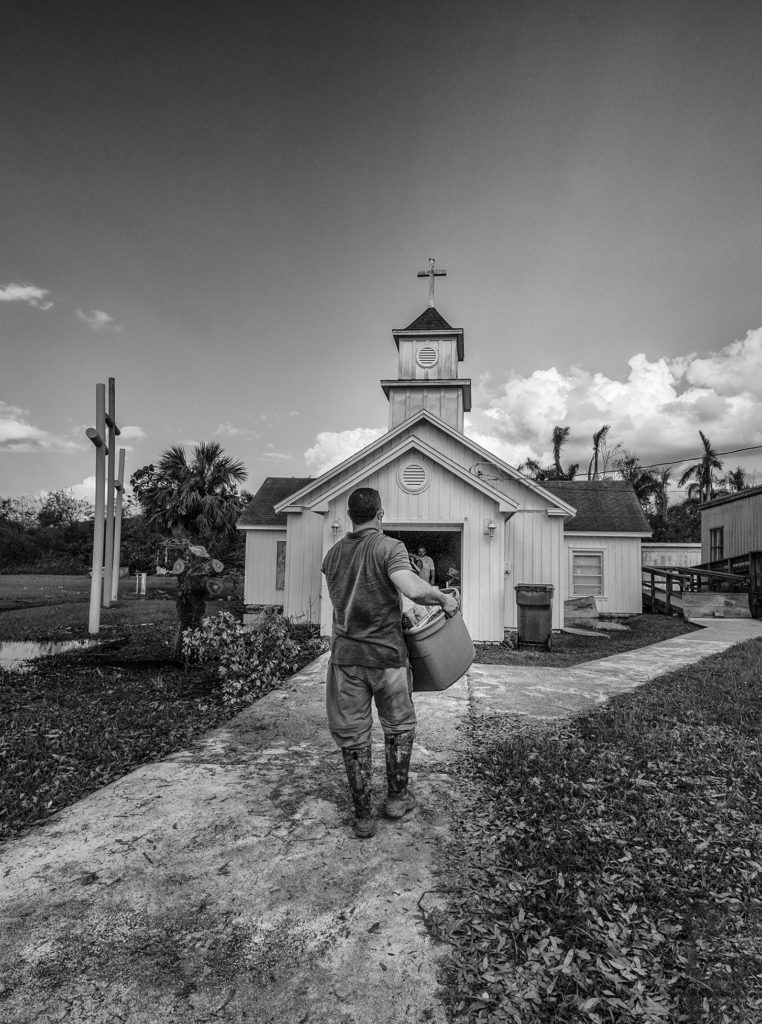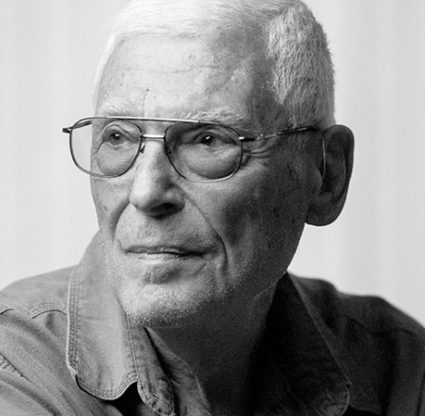The day after a deadly 9-foot surge of floodwater rose from the Ten Thousand Islands and Chokoloskee Bay, leaving homes in Everglades City, Chokoloskee Island and their neighboring communities shin-deep in slimy sludge and a landscape of ruined homes, The New York Times ran a story headlined The Monster Storm Surge that Wasn’t. If they’d had access to a newspaper (or any other media) that day, such an outrageous headline wouldn’t have surprised the people of the self-named Last Frontier. These gladesmen and fishermen are accustomed to being overlooked, after being devastated by the Great Hurricane of 1910, Donna in 1960 and Wilma in 2005. So when Irma’s floodwaters receded, they did what they’ve always done. They assessed the situation, squared their shoulders and got to work. There were the heartbreak of loss, injuries and infections that sent people to the hospital, and the frustration of endless bureaucracy. But one year later, a different story emerges. One of neighbors helping neighbors, a fresh outlook for the future and, most of all, the incredible kindness of strangers.
Five Days on the Job
On Sunday, Sept. 10, 2017, Howie Grimm, whose extended title is Mayor of Everglades City, Stone Crab Capital of the World, was exactly five days into his post as mayor. A stone crabber by trade, he’d inherited a decade worth of problems, including nasty politics and an even nastier sewer system. “My mandate was to rebuild trust, introduce transparency and repair our failing infrastructure. ‘Well,’ I thought, ‘at least it can’t get any worse.’ And then it did.”
The sun rose on Sept. 11 over a thick carpet of mud, infiltrated with decaying sea life and human sewage and imbedded with deadly shards of glass, nails, splintered wood and sheet metal. With sweltering 100-plus-degree temperatures, the stench was unimaginable.
A quarter of the 400 residents had lost their homes. A majority of others lost most or all of their possessions, soaked in standing water as high as 5 feet. The road into Everglades City was underwater. The Chokoloskee Island bridge was impassable. The mayor’s elderly mother lost her home, as did City Clerk Dottie Joiner. Yet both Grimm and Joiner were on the job first thing Monday morning. Their “office” was Dottie’s truck, which would be ground zero for a week until a trailer could be brought in. Community leaders with epic losses of their own gathered to mobilize and assign tasks. Local real estate agent Karen Cochran would be the point person for FEMA and any other relief organizations that might come. Connie Barker, on behalf of Everglades Community Church, accepted the task of distributing food and emergency supplies, and directing volunteers each day to where help was most needed. Tony Pernas, of the Everglades Lions Club, and Jim Ragusa, principal of Everglades City School, would lead a new support organization called the Communities of the Everglades Disaster Recovery Committee (CEDR).
Locals were so accustomed to going it alone that they were completely unprepared for what happened next. People came by the thousands: organizations and individuals of every faith, major national companies, local businesses, high schools and colleges, and ordinary citizens who just wanted to help.
Ice-cold Watermelon and Other Miracles
It’s Day Two. Martha Hutcheson is trying to scrape 8 inches of slimy, bacteria-infested mud from her floors. She’s barefoot, slipping and sliding in the muck, when a friend drives up. “‘We have tools—what do you need?’ he asked, but in my dazed state, I couldn’t think,” she says. “I only knew that in a few hours this place would be mold heaven. But as he was driving away, I remembered. ‘Wait! I could use some boots.’ He backed up, grabbed his own boots and they were mine.
“And the miracles kept happening. I’d need something and out of the blue it would appear. I’m now trying to cut out sludge-soaked carpet, strip by strip, with a small razor knife. It’s 103 degrees outside and worse inside. All I can think of is ice, which doesn’t yet exist. Suddenly a guy with out-of-town plates pulls up, his pickup piled with ice-cold watermelons. How could they possibly be ice-cold except by miracle? That watermelon was the most delectable thing I’ve ever tasted in my life.”
“Some of the things perfect strangers thought to do for us for moved people to tears,” says Kathy Brock, publisher of the community newspaper, The Mullet Rapper (still 25 cents). Like that first week, when people were boot-deep in putrid mud inside their ruined homes. “It’s hot and everyone’s in a funk. A van rolls up and a woman calls out, ‘Hi! We’re from Sarasota and we’ve just cooked some chicken wings.’ We look inside and there’s all that beautiful, fragrant chicken, enough for the whole town. One woman is holding a big container of celery; another one has the blue cheese dip. Those women drove more than 2 hours to bring that chicken. Imagine that kind of charity!”
There was the humble act by a group of Marco Islanders who provided free laundry service. And the couple who drove down from Bonita Springs in a pickup loaded with coolers, calling to everyone they saw, “Can we give you an ice-cold beer?”
“There must have been 300 cans of beer in those coolers,” Brock says. “The husband said, ‘My wife and I knew there’d be water, but we thought, what those people need is a beer.’”
Dulce Valdez and her husband, Carlos, own the iconic Havana Café, Chokoloskee’s only restaurant, which was heavily damaged. But it’s not flooding and loss that Dulce talks about, or how her family helped others. What touched her most were the kids who came to the door saying, “Excuse me, may we take away your trash?”
“It was good for the younger generation to see what true community spirit looks like,” she says. “Our kids are seeing how people sticking together have pulled through; that if we made it through this, we can make it through anything.”
“We had more help than anybody on the planet,” says Kenny Brown, who manages the Outdoor Resorts of America RV Resort on Chokoloskee Island. “Some of it came from Florida’s poorest counties. Guys showed up with chainsaws and said, ‘Give us a job. We’re here to work.’”
Cash with Compassion
Brown still marvels at the gentle Chinese volunteers from Tzu Chi who fanned out across Chokoloskee (and beyond) dispensing music and encouragement along with $400 debit cards. Tzu Chi is a UN-accredited foundation that serves victims of disaster. “I wondered if they’d try to make us all Buddhists,” he jokes, “but they asked for nothing.” Although the money has long been spent, Brown still keeps the card in his pocket.
In all, Karen Cochran registered more than 1,300 volunteers who logged 8,400 hours, in the initial muck-out period alone. Not including, adds Connie Barker, the scores of people who drove through performing random acts of kindness without checking in.
The People of Vermont
The only picture that graces Mayor Grimm’s newly reoccupied office is an unlikely one. It’s a photo of a Christmas card-perfect New England home on a snowy night. Inscribed below it is the message, “The people of Woodstock Vermont want you to know we are thinking of the people of Everglades City.”
“The people of Vermont! Can you believe it?” the mayor asks. “And they sure did more than think about us. They got the names, ages and wish lists of all our children, and then they showed up the week before Christmas with a Vermont Christmas tree and piles of presents. And they’re coming back to help with our next stage of recovery.”
The Kids Are All Right
With a flooded school building, Principal Jim Ragusa had plenty on his plate. But he knew that some of his students had nothing, literally, on their plates. Even those who hadn’t lost their homes watched their ruined beds, clothes, toys and other treasures being piled up on the street. Ragusa knows what that feels like. He lost his own home in Hurricane Andrew. So the principal, who commutes about 3 hours round-trip daily from Fort Myers, bought groceries with his own money and then cooked and personally delivered meals to the students and their families. The kids’ emotional well-being was his No. 1 priority. No. 2 was to restore the gym so that his 11 graduating seniors could have their traditional ceremony in the school they’d attended since kindergarten.
“Contractors said there was no way it could happen by June,” says one parent with a grin. “But they forgot who they were dealing with. The first basketball game, staff vs. students, took place in the brand-new gym a full week ahead of graduation.”
Delay: Not an Option
Irma unleashed her fury on Sept. 10, giving stone crabbers exactly 34 days to repair their boats by the opening of stone crab season. Livelihoods were at stake. Being late was not an option. On Oct. 15, blessings said and rose petals scattered, the boats were on the water.
Also not an option was canceling the Everglades Seafood Festival, as proceeds go to the town’s critical needs. Carol Foss, who chairs the festival, was fast-depleting her savings and energy getting her Island Café back in business. Nevertheless, the 48th Annual Seafood Festival didn’t simply go on: Instead, it shattered all previous records, with 60,000 in attendance.
Carolyn Thompson, owner of Win-Car Hardware, was well past retirement age and mourning the recent loss of two sons when the floodwaters wiped out the store. “I honestly didn’t have the heart to start over,” she says. “But everyone said, ‘We need you.’” So she cashed in her small retirement account, blasted the place with bleach and reopened in May.
The Damage Is Perception
People who make their living catering to the first-time Everglades experience say that the county visitor’s bureau isn’t adequately getting the word out that, although the Everglades National Park’s visitor center is closed, the park is open. The fishing is great and the wildlife abundant, they say, but the misconception has kept customers away.
Grimm intends to correct those misconceptions. “I’m fixing to get more involved in Collier County’s marketing efforts,” he says. “I plan a sit-down with [CVB Executive Director] Jack Wert. Everglades City was the beginning and it’s still the jewel, bringing in hundreds of millions of dollars.”
“Also,” Chokoloskee fishing guide Kent Daniels wants tourists to know, “Irma wiped out the local mosquito population. After Wilma we had zero mosquitoes on Chokoloskee for five years.”
Five years may be a bit of a stretch following Irma, but some who fished the backwaters last summer say at least for the short term it’s true.
It’s Personal
A safe, sanitary place to sleep. Manual labor to help with repairs. A ride to the dentist. Food. Diapers. Funds to start over. For people dealing with the emotional and physical effects of a disaster, finding such resources for life’s basics while navigating confusing insurance, FEMA and other paperwork is overwhelming. Enter Kathy Curtis. The Marco resident is on loan to CEDR from the United Methodist Committee on Relief. She helps families prioritize their needs and then connects them with supplies and services. For her, it’s personal. She, too, lost a home to a hurricane. (Hers to Andrew.) She’s still working with 64 families, and she expects more as people exhaust their own resources. “Each time something comes through for a client,” she says, “I feel a surge of happiness. Then I get back to work.”
Don’t Forget the Halos
“If you take a picture of Tony and Tammie,” says Martha Hutcheson, “be sure to put halos over their heads, because they’re angels. First thing after the storm, they were out checking on the neighbors. Taking one look at me covered in mud, they said, ‘Give us an hour and we’ll be back to get this done.’”
Tony Pernas is a botanist with the National Park Service. Tammie Pernas is Everglades City manager. Remembering the kindness of others when they lost their home in Hurricane Andrew, they’re paying it forward. Through their leadership roles with the Everglades Lions Club and the Lions Foundation of the Everglades, respectively, they’ve also raised substantial relief funding for the town. “Our home is on pilings, so we had some damage, but we were safe,” Tammie says. “We just wanted to volunteer where the need is greater.”
Mayberry
“Everglades City is a step back in time. I call it New Mayberry,” Tammie says, and, indeed, there’s a Mayberry ambience about the whitewashed steepled church, quirky cafés, imposing Neoclassical Revival-style city hall and palm-fringed Old Florida cottages. But a closer look reveals that many of those cottages are empty, some missing windows or doors and inside, some wearing chest-high water lines.
In happy contrast is the sparkly-fresh cottage of high school sweethearts Kenny and Temple Dampier and their 10-year-old son, Trenton. They’d also been through Hurricane Andrew, so despite their new hurricane-resistant roof, they had no interest in riding this one out. So they packed up their valuables, including Kenny’s movie memorabilia and Trenton’s colorful stuffed snake collection, and evacuated. The new roof held, but the flood ruined everything inside. “I thought at least the linens and towels would stay dry in the bathtub,” Temple says with a rueful laugh, “but it was filled to the brim with mud.”
This weekend, the young family is moving back in. There’s much left to do, but Trenton still has his snake collection, and he’s joyfully awaiting the UPS truck that will bring his new bed with a storage drawer underneath.
To Elevate or Not to Elevate
Fishing guide Bruce Hitchcock is kind of a Hemingway of the Ten Thousand Islands. Instead of the written word, his art is photography. Mahogany-framed Everglades photographs share the walls with fishing memorabilia and seashells inside his rustic fisherman’s retreat on pilings overlooking his boat’s dock. Instead of six-toed cats, his companions are two tail-less cats (one by genetics and one by the vagaries of life) and a parrot named Willy.
At 18 to 20 feet above sea level, Chokoloskee sits on a Calusa shell mound and is the highest ground in the Everglades. “Still, in a high-velocity flood zone, water will come in with drastic force,” Hitchcock says. “Building this house on 20-foot pilings kept the upper level dry, but underneath, I lost $20,000 worth of tools, tackle and appliances. Every time, you learn something. Going forward, I guarantee I’ll be doing some things differently.”
The future survival of these communities depends on the way existing homes are reconstructed and new homes built, says real estate agent Bob Wells, especially in areas like Plantation Island, which sits at sea level. “Yes, there will be some inconveniences. For example, you have to bring in fill dirt from outside. But elevated homes will have the best chance of survival.”
“The next storm isn’t if—it’s when,” says Grimm. Once we get the infrastructure in place, we’ll address the raising of the fire station, and even the roads. My mission is to keep the forward motion, and there’s progress every day.”
Patty Huff, the founder of The Mullet Rapper, and her husband, Steve, a well-known fishing guide, are passionate about historic preservation. Their home, one of the original 1920s Collier cottages set on the banks of the Barron River, took a big surge. But without drywall, and with most of the furnishings and the house itself being wood, it survived. They had no insurance. “We used our savings to do the critical mucking out,” Patty says. “The rest can be done over time.
“With climate change and sea level rise, we must accept change; fix it so we don’t have to go through this again. Steve and I are in our 70s. If we were younger, we’d definitely consider raising our home. At this age, we’ve chosen to do all we can to improve its resistance.”
The Dampiers are keeping their options open to elevate in the future. “If grant funds become available, we’ll consider it,” Temple says. Many of their neighbors are also struggling with that decision.
“Irma woke everyone up,” Kathy Brock says. “It forced us not just to repair the damage but also to make us better.” Tony Pernas strongly agrees: “I’m envisioning 10 to 15 years down the road, when Everglades City is hurricane-resistant—most homes on stilts, with architecture and landscaping designed to protect and preserve our uniqueness.”
Indeed, if one considers the long, skinny-legged great egret wading tall in the River of Grass, or the red mangrove emerging from the shallows on its prop roots, a thoughtfully designed stilt home is right in keeping with the character of the Last Frontier.
Author’s Note: As I descend the steps of City Hall, bells chime out a familiar hymn from the circa-1926 Everglades Community Church that looks brand-new. Oh, wait. It is brand-new. Palm trees cast feathery shadows on a lush green lawn where workers are setting in new rows of plants. Down the road, Temple Dampier is surveying the mountain of fill just delivered for her yard. I absolutely believe Mayor Grimm when he says, “When we look back at this event and the years that followed, we’ll say, ‘Wow! What a tough bunch of people we are.’”
How to help …
Foundations and grant providers: Anna Marijka
Donations and other support: Everglades City Hall, (239) 695-4558
Sign up for an Everglades and Ten Thousand Islands experience. For outfitters, restaurants and accommodations, visit evergladescityfl.org.





